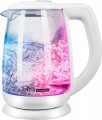Volume
The nominal capacity of a kettle refers to the maximum amount of water that can be safely poured into it, and it is typically indicated by the water level indicator. In the case of brewing sets (see "Type"), the nominal capacity refers to the main kettle, while the capacity of the teapot is listed separately (see below).
The capacity of the electric kettle directly affects the amount of water that can be heated at once. A larger capacity allows for heating more water, but this also means the kettle will be larger and heavier. Additionally, heating a larger volume of water requires either more power or a longer time. Therefore, it is important to consider one's actual needs when choosing a kettle based on its capacity. For example,
mini-kettles for travelling (or for one person) have a volume of up to 1 liter. For home use in a family of 2 – 3 people, a 1,5 – 2 liter model is enough. Devices for
2 – 3 liters are already well suited for a small office or a similar situation. The most spacious electric kettles are designed to hold 10 liters or more, and are typically used in public places such as canteens and cafes for dispensing hot water.
Water level indicator
A device that allows you to estimate the amount of water in the kettle without opening its lid. Most often
the water level indicator has the form of a scale applied either to the transparent wall of the container, or to a transparent insert in an opaque wall. In any case, this function allows you to measure the volume of filled water quite accurately, and not just determine it “by eye”. This possibility is especially important for models with open coils (see "Heating element"), in such devices, a mark on the indicator is usually applied to the minimum allowable water level.
Thermometer
A device that displays the temperature of the water in the kettle. The presence of a
thermometer is useful if the water needs to be heated to a certain temperature. However, the thermometer does not automatically turn off the kettle, unlike a thermostat — this must be done manually. Also, the thermometer allows you to assess how much the heated water has cooled over time and whether it can be used without heating again.
Opening the lid with a button
Kettles (see "Type") in which the lid opens at the touch of a button. This opening is faster and more convenient, and often safer than the traditional way (grab the lid and pull it up): the lid can get quite hot when the kettle is in operation, and long contact with it is fraught with burns. And although the button can also be placed on the lid, a short press is enough to activate it, and even in such cases the risk of getting burned is minimal. On the other hand,
opening the lid with a button complicates the design of the kettle and reduces its reliability.
Body shape
The general shape of the body of the electric kettle.
—
Conical. The most popular option: a body is wide at the base and tapering upwards. This form contributes to stability: the centre of gravity is maximally displaced downwards. However washing such a kettle from the inside may not be very convenient due to the relatively small size of the opening in the upper part.
—
Cylindrical. The cylindrical shape provides more or less the same width of the body at the base and at the top. With the same height and base diameter, such kettles hold slightly more water than conical ones; in addition, such a device is easier to clean due to the wide opening for the lid.
—
Inclined. The body which is inclined forward; the width of such a body is usually more or less the same over the entire height. Such kettles have an unusual, eye-catching appearance; in addition, it is easier to pour water from them — the device must be inclined at a smaller angle than with a cylindrical and even with a conical body. However, this option does not provide fundamental advantages over the same cylindrical shape, but it is more expensive, and therefore is not common.
Controller
The name of the controller installed in the device.
The controller is called an electronic circuit, which is directly responsible for managing the operation — primarily for turning off the heating when boiling or turning on without water. In our catalog, the name of such a circuit is specified if we are talking about an advanced controller that significantly exceeds most solutions on the market in terms of quality and reliability. At the same time, the specs indicate not a specific model, but a general brand — this is quite enough in this case.
The most reliable, durable and safe nowadays are the controllers of the British manufacturers Strix and Otter. There are no fundamental differences between these options in this regard, any of them is a sign of a quality kettle (even if the overall functionality of the device is rather modest). On the other hand, such equipment affects the price.

